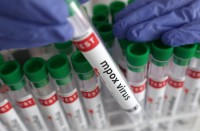LONDON
(Reuters) – Combining two types of polio vaccine, including one that is injected rather than given orally, appears to give better immunity and could speed efforts to eradicate the crippling disease, scientists said on Friday.
British and Indian researchers said the inactivated polio vaccine (IPV), which is given by injection, could provide better and longer lasting protection if given alongside the more commonly used live oral polio vaccine (OPV).
Serious polio outbreaks in Asia, Africa and Europe over the last 10 years have hampered efforts to wipe out the disease, caused by a virus that replicates in the gut and can be passed on through contact with infected faeces.
Polio invades the nervous system and can cause irreversible paralysis within hours – and the World Health Organization’s repeated warning is that as long as any child remains infected with polio, children everywhere are at risk.
Most vaccination campaigns – including emergency ones that were started last year covering 20 million children in Syria and neighboring countries – use multiple doses of OPV to boost immunity among those at risk.
“Because IPV is injected into the arm, rather than taken orally, it’s been assumed it doesn’t provide much protection in the gut and so would be less effective at preventing faecal transmission than OPV,” said Jacob John, an associate professor at the India‘s Christian Medical College, who led the study.
But his team’s research, which covered 450 children from a densely populated urban area in Vellore, India, found that where they already had a level of immunity due to OPV, the injected vaccine actually boosted their gut immunity.
“It looks as if the strongest immunity can been achieved through a combination of the two,” he said.
Polio re-emerged in Syria in 2013 for the first time in 14 years, fanning fears of a wider international spread and prompting a vast regional emergency vaccination campaign.
CHILDREN VULNERABLE
Children in unsanitary conditions are particularly vulnerable to infection with the polio virus, which can spread through contaminated food and water.
Although transmission of indigenous polio has been declining substantially in endemic areas since 2012, around 10 countries are currently considered to have active polio transmission.
Polio is still endemic in three of these – Afghanistan, Pakistan and Nigeria – and the remainder are countries that were once polio-free but have been re-infected.
The Indian children involved in the study, by John’s team working with researchers at Imperial College London, had all received OPV during standard vaccination programs.
Half of the children were given a dose of the injected IPV vaccine and half given nothing, and a month later, the children were given a “challenge” dose of the live oral vaccine to simulate reinfection.
Their stools were tested after a week to see if the polio virus was present, specifically the two remaining types which have not yet been eradicated – serotype 1 and serotype 3.
In the children who had received IPV, 38 percent fewer had serotype 1 in their stool and 70 percent fewer had serotype 3, compared to those who had not been given IPV, according to the study results published in The Lancet medical journal.
“An additional dose of the injected vaccine is more effective at boosting immunity against infection than the oral vaccine alone,” says Nick Grassly, a professor of vaccine epidemiology at Imperial.
“This implies that the IPV could be used to boost immunity in people travelling from or to polio-infected countries, such as Afghanistan, Pakistan and Nigeria. It could also replace some of the OPV doses in immunization campaigns to boost gut immunity, particularly in areas of poor sanitation.”
(Reporting by Kate Kelland; Editing by Andrew Heavens)








